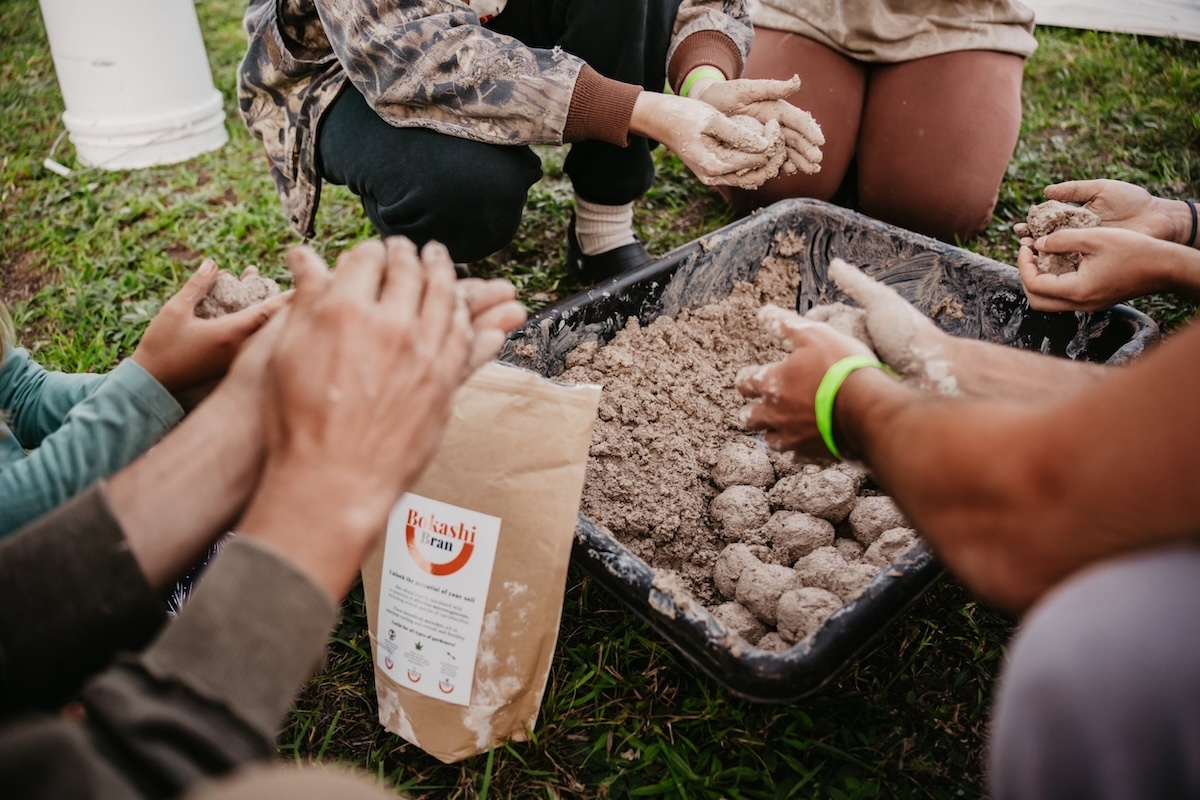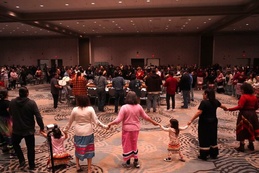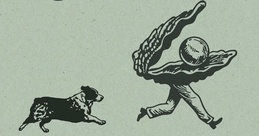
Welcome to Camp Compost
Inside the regenerative farming event held Aug. 15-17 in Central Lake
By Anna Faller | Aug. 2, 2025
As humans, it can be easy to forget that there’s a whole universe under our gardens and lawns, one that’s vital to the health of our ecosystems and all the lives they sustain (including our own). In fact, a single spoonful of soil should contain more microorganisms than there are people on earth!
Many modern agricultural practices, however, can seriously disrupt that delicate balance by stripping our soil of its microbiology (think: fungi, bacteria, nematodes, protozoa, etc.) or introducing harmful chemicals. And, when allowed to continue, those actions can incite serious ecological issues, from decreased crop production and nutrient density to erosion, toxic algae blooms, and beyond.
Learning to support our soil through practices like composting, however, closes the loop, thereby ensuring that those systems are equipped to survive and thrive for years to come.
“I like to think of soil as the foundation to all life,” says soil health consultant and educator Alexa Kipper. “When you have healthy soil, ecosystems flourish and people are healthier. It creates a ripple effect that we can see on so many levels.”
All Things Dirt
The seed for Camp Compost took root about five years ago, when co-organizers Kipper, Chandler Michalsky (operations manager at Grand Rapids compost company Wormies), and Mike Freund (of regenerative farming initiative Kuleana Consulting), discovered their shared passion for all things dirt.
“We knew of each other from [social media], but when we all met in person at this event, it just clicked,” says Michalsky. It also didn’t hurt that Freund had a large piece of land he was hoping to use for events.
Fast-forward through two short months of planning and the inaugural Camp Compost gathering, originally known as the Michigan Compost Cup, kicked off in September 2021 with an attendance of about 30 people.
“We started off wanting to have a competition where compost makers could bring their stuff in, we could all check it out, smell it, and [talk] about the different parameters of what good compost is,” Michalsky explains.
After reviewing participant feedback, though, the group ultimately ditched the contest, instead opting for an event that could serve as both a community hub and a learning experience. “We just wanted to have a fun event where we could celebrate compost, teach people how to do it, and be welcoming to everybody,” Michalsky says.
Part One: Compost
Now heading into its fifth season, Camp Compost has since bloomed into a weekend-long celebration, not only of soil but also of building community and living in a more reciprocal way. It takes place on a stunning 22-acre plot in Central Lake, just four miles from Torch Lake’s north end, and encompasses a jam-packed schedule of hands-on classes and workshops for about 150 attendees.
Each day, campers can choose from a full itinerary of soil-centric activities, which run between about one and two hours and take place at various sites throughout the grounds. Most of these have a regenerative or agricultural bent—soil microbiology, worm casting compost, beekeeping, etc.—but there are a few outliers in the mix, like yoga, foraging, or breathwork, for instance, which allow attendees to unplug.
This year, headlining speakers include Chris Trump, creator of Biomei Natural Farming Solutions and an expert in Korean Natural Farming (KNF), and Stephen Raisner, founder of PlantPonics and aquaponics industry leader.
“They’ve both traveled all over the world, educating farmers on how to do this. They’re a big deal in our eyes, so we’re very fortunate to [host] them and have them share their information,” Michalsky says.
Also on the 2025 roster are course topics like micro-homestead design; learning the basics of canning fresh produce; quantum biology fundamentals; and a hands-on demonstration of Bokashi composting (a fermentation method using an airtight container and micro-critters), all helmed by local educators.
“They’re extraordinary!” Michalsky adds. “[Our presenters] all have something to share, and they can relate to everyone, because for the most part, we’re all just trying to do this in our own backyards.”
Part Two: Camp
Once activities start to wrap up for the day, attendees can either head home or set up camp and sleep under the stars (which, per Michalsky, is part of the magic).
Options here include car- or tent-camping at one of the property’s connected sites, which are large enough to house multiple groups, or hammocking in dispersed foliage. There are no cabins or huts onsite—nor is there power, to encourage connection with nature—though, there is a series of portable toilets, as well as four camp showers, one with hot water. Guests also have access to a sink setup, a drinking water refill station, and a domed greenhouse packed with lounge furniture and fairy light strings for evening festivities.
“It’s a really cool space where everyone connects,” Freund says. “In the past, we’ve seen people become friends [there], and now they meet up every year at the event.”
Other attractions include the Main Stage which hosts live music sets at night, a bonfire pit for drum circle sessions, an onsite spring, and the Giving Tree, where attendees can leave and take offerings of clothing, jewelry, tinctures, or other trinkets.
In addition to the daily demos, there’s also a farm market feel throughout the event. Per Freund, this includes onsite vending provided by several local businesses, headlined this year by Providence Organic Farms (Central Lake) and a regenerative pig farmer for protein-based snacks.
Guests can also expect coffee service, as well as a smattering of organic confections and unique wares, like home-dyed clothing, jewelry, tea blends etc., provided by crafty attendees.
Stewards of the Earth
What’s even more unique than the shopping, though, is the tight-knit community campers have formed.
“One of the things that I’ve noticed is that it’s become like a big family,” Kipper says. “A lot of the same people come back year after year, so it feels like you’re in a warm hug with your friends all weekend.”
In this regard, Freund hopes Camp Compost stays the same; though, he does hint at the possibility of further property development down the line. Also on the immediate docket is continuing to increase audience size and building on the event’s success to garner a more diverse attendance. In other words, the more communities are exposed to the information and tools Camp Compost supplies, the greater and more positive the ecological impact will be.
“We want it to be a sacred space as stewards of the earth together,” adds Kipper. “It’s all about giving people the tools they need to go home and create meaningful change in their lives so we can transform from the ground up.”
Composting Basics
If your goal is to harvest your compost to grow food or feed a garden, it’s important to offset nitrogen-rich matter like food scraps, manure, grass clippings, etc. with a separating layer of browns, like cardboard or straw, which have a higher carbon content. If possible, Michalsky recommends aiming for a 60- to 40-percent split, respectively—not only will this create balanced compost, but it’ll also help control smells and critters!
When you’re working with a smaller space, or if you have neighbors to think about, worm bins also make great starter kits. All you need is a plastic tote, some food scraps, and a few wriggly guys to reap the benefits. (The byproduct, which is worm manure, is also the most potent variety for plant fertilizer!)
You’ll know your compost is finished once it’s reached a rich dark brown color—that’s an indicator of humic acid from decomposition of organic matter—and clumps together when you squeeze it, which is a quick way to test for microbes and moisture.
Per Michalsky, another indicator of compost that’s ready is a forest floor aroma. “Finished compost should be calming,” he says. “It should smell good, literally like the forest after it rains.” Conversely, if your compost smells sour or off-putting, it’s too early for use.
Want your compost to include animal products like meat and dairy? The trio recommend going the hot route, which requires significantly more area and upkeep to maintain the operative temperature (130-160 degrees F).
If you have the space and the means, though, don’t be afraid to throw everything in one big pile! “People think you have to do certain things, but soil is like the digestive system of the earth—the microbes will take care of everything,” says Kipper. Adding a symbiotic bran product, like Bokashi, can also help streamline the process. In fact, she says, the only true composting no-no is putting it in a landfill!
For more information on Camp Compost, helpful resources, and online ticket sales, visit campcompost.com.
Trending

Our Top Stories of 2025
Each year, we look back at the stories we’ve shared over the last 12 months and pull together the ones that got the mo… Read More >>
A Solo Rattler
Frontman of folk-rock band Michigan Rattlers Graham Young brings his solo performance to Great Lakes Center for the Arts in … Read More >>
GTB Starting the Year with Tradition
The Grand Traverse Band of Ottawa and Chippewa Indians hosts the Kchi Wiikwedong Anishinaabek Maawnjidowin Round Dance on Ja… Read More >>


